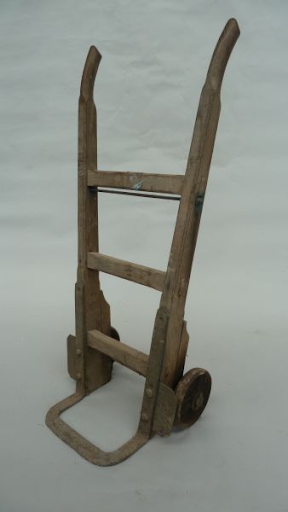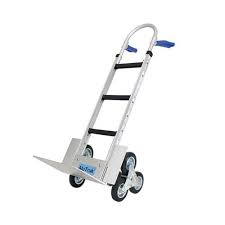The sack truck was invented during the industrial revolution in England (19th century). They were originally designed to help unload spices off ships coming from the Caribbean and what was known as the East Indies (Indonesia, Philippines etc). The use of Sack Trucks became crucial to the businesses operating in the spice trade as a 10-year-old boy could now do the work of an adult without injuring themself. This was because the Sack Truck had what is known as a 1st class lever system, which means you can carry a lot more weight with the same or less effort due to the effects of levers. As a result, companies could save expenses as they didn’t have to pay the boys as much money. This idea was then caught on by other companies, who then implemented the Sack Truck for unloading trains as well. Which ultimately gave the more well-known name of Railway Porter.
The first sack trucks used where made initially out of wood (usually oak or other strong wood), with the separate pieces being bolted together. This made them easy and cheap to make whilst still being efficient and easy to use. However, the wood made to sack truck heavy and hard to manoeuvre. This was not helped by the thin wheels that would make turning corners rather difficult. Despite this it could still transport a large amount of weight. This was aided by the small platform at the bottom of the sack truck, which made balancing crates and other goods easier, therefore maximising the amount that can be carried in one load. 
The next design change came in the early 20th century when the material changed from wood to cast steel or iron. This was when molten steel was poured into a mould and left to cool. As a result,
the metal cooled into the shape of the sack truck. There were some versions that had steel plates wielded or bolted together, with the wheels bolted onto an axle along the bottom the sack truck. This made the sack truck even heavier and less manoeuvrable. However, it did make it extremely strong and capable to carry larger weights easily. 
The next innovation for the sack truck was another change in the material again later on in the 20th century. This was the change from cast steel or iron to tubular steel. Tubular steel is a hollow cylindrical tube made out of a thin outer layer made of steel. This made the sack truck much lighter but it didn’t lose any strength. This made it a lot easier to manoeuvre and use. As well as this, it would be easier to repair if it every broke due to the large amount of tubular steel being used in the world, meaning spares would be easy to come by. This also meant that they were now much easier and cheaper to make and transport. Consequently, they could be mass produced and shipped out to the rapidly increasing number of warehouses that needed them. The design was so good on the tubular it is still used today on modern designs. 
Along with the modern designs of tubular steel, there are aluminium versions as well. These aluminium sack trucks are even more light weight but still have similar strength to the tubular steel. This allowed the carrying capacity of the sack truck to go over 200Kg, whilst weighing under 10Kg. Whereas the steel sack trucks can get more carrying capacity but at the cost of weighing a couple of Kg heavier. As a result, the aluminium sack truck is a lot easier to manoeuvre. However, the aluminium is not quite as durable as the steel versions but still has a long lifespan.
A fancy new feature that has come along with the development of materials is the ability to fold a sack truck (known as folding sack trucks) down to a much smaller size, making it easier to transport and move when it is not in use. What usually happens is that the folding toe plate of the sack truck can be lifted up to fit closely with the rest of this frame. The upper half of the sack truck can also be folded down or slid inside of the lower half, along with the wheels being able to fold inwards to further reduce the amount of space it takes up. This reduces the space the sack truck takes up. Therefore, allowing more to fit on a pallet and making it easier to transport and store when not in use. 
With the introduction of pneumatic wheel, it revolutionised the way sack trucks operated. As they no longer had to have thin rubber tires or wheels made entirely out of metal or wood. This led to weight being saved and the manoeuvrability increased massively. They also allowed for a smoother ride, meaning that you are less likely to drop something going over a bump. Pneumatic tires also provide more grip and traction for lose surfaces. These tires have also made way for some crazy designs. As many brands are now offering a version that can climb stairs (stair climbing). This is done by three pneumatic wheels being held together in a triangular shape. So, when the bottom wheel reaches the joint on the stair the top wheel gains traction and the axle rotates forcing the sack truck up the stairs. This makes transferring goods upstairs so much easier, more efficient and a lot safer. 
Another invention that has been evolved into the new sack trucks is involving brakes (manual handling). This is when the sack truck has two separate handles, that have a brake lever on them. When squeezed the brakes will be applied and the sack truck will slow down and come to a stop. This will allow the user to have much more control of heavy loads on sloping terrain.
Just to be confusing a sack truck has several names across the globe. An American version is a Hand Truck, which has the same purpose and design as a sack truck. Another term used is a Sack Barrow. This British term is used as the devise is used to carry sacks and barrow is a term used for a devise used to carry something (the same terminology in wheelbarrow).
Overall, the main changes made over the last 200 years are:
-
Materials used – wood – iron – steel/aluminium
-
Carrying Capacity - 200Kg +
-
Weight - ˃10Kg
-
Wheels – iron – pneumatic/solid rubber/puncture proof
-
Added Features:
-
Stair Climbing
-
Brakes
-
Folding
However there has been very little change to the original design of the sack truck. Showing how efficient the technology is to this day.
